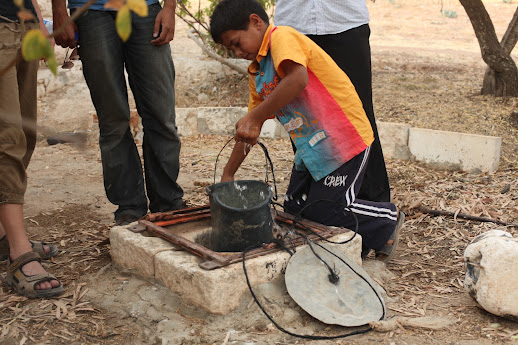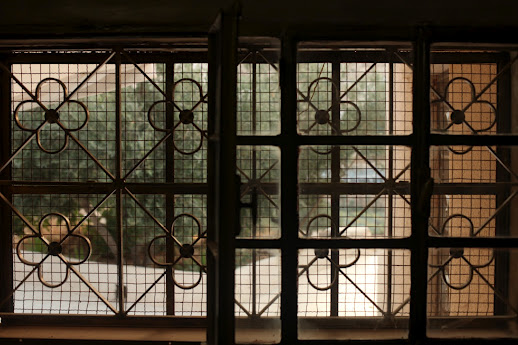By Patrick Keddie
4 August 2012 | International Solidarity Movement
The Israeli authorities’ attempts to ethnically displace Palestinians from East Jerusalem have intensified greatly in recent years; in some areas, such as Sheikh Jarrah, eviction notices have been handed out to nearly every Palestinian family. My Neighbourhood, a recent short documentary film produced by Just Vision, examines the struggles against mass Palestinian eviction and asks important questions of how to resist.
The film focuses on Sheikh Jarrah, an area less than 5 minutes’ walk from the opulent American Colony Hotel (favourite haunt of foreign journalists, NGO workers and politicians). The main protagonist is Mohammed El Kurd, an ebullient and thoughtful Palestinian teenager who experiences the trauma of partial eviction, as half of his house taken over by Israeli settlers.
In August 2009, Mohammed’s neighbours were evicted by Israeli settlers, supported by the Israeli authorities, who broke down the doors and smashed windows to force out the distraught Palestinian family living there. Mohammed remembers “a lot of policemen, a lot of angry faces.” The house is now garlanded in Israeli flags and rigged with Closed Circuit Television cameras.
In My Neighbourhood, a spokesperson for the Sheik Jarrah Settlers Group declares that evictions are justified because the Bible decrees that the area belongs to Jews. Angry settlers are shown descending on the area after Shabbat prayers, some brandishing automatic weapons and chanting, “in blood, in fire, we will kick out the Arabs.”
In November 2009, a group of settlers forcibly claimed half of Mohammed’s house – an extension built by the family without permission (it is almost impossible for Palestinians to acquire building permits in Jerusalem under Israeli law). Three young settlers, rotating in three month shifts, have since occupied the front half of the house, whilst the 13 members of the El Kurd family live in the back. Inevitably, this bizarre situation causes huge tension and resentment. The El Kurd family are subject to regular provocation and harassment, whilst their attempts to reclaim the rest of their house have failed.
Like many others in the neighbourhood, Mohammed’s family arrived as refugees. The El Kurds moved into the house in 1956 after being forced out of Haifa during the 1948 Nakba. The attempt to evict them from their current house would be a second ethnic displacement. Palestinians in Jerusalem endure a precarious existence under Israeli law; they are not recognized as Israeli citizens and can be stripped of their residency at any moment, with little recourse to the law. If the family is evicted they will likely be forced to move to the West Bank and prevented from returning.
A protest movement against the Israeli settlements in Sheikh Jarrah quickly grew, partly organized by Israeli peace activists. My Neighbourhood features Zvi and Sara Benninga, young leftist Israeli activists, who are at the forefront of organizing solidarity protests in Sheikh Jarrah. The protests against the evictions initially attract 20 to 30 people and eventually culminate in a rally of around 3000 protesters. Over the course of two years, Mohammed overcomes his initial scepticism and forges strong relationships with the Israeli activists.
By 2011, an uneasy stalemate has been reached. Settlers still occupy half of the El Kurd’s house but the protests have helped prevent any further evictions from taking place in the neighbourhood. Zvi Benninga argues that “Sheikh Jarrah elicits hope.”
However, in a talk after a screening of the film at Amnesty International, co-director Julia Bacha said that the achievement should be seen in context, “It’s a pause” she said, “nowhere near a victory. Literally, Mohammed could be evicted tomorrow from his house.”
Mohammed states his ambition to become a human rights lawyer to “use the law to evict them.” However, whilst international law condemns the occupation and the attempts to forcibly create settlements in occupied territory, Israeli law is systematically designed to facilitate occupation.
Settlers have found or forged deeds from the Ottoman era, purporting to show that the area used to be occupied by Jewish inhabitants; under Israeli law, this can facilitate the eviction of Palestinian properties. It seems a wider challenge to the law and the structure of occupation itself is required.
How to resist in the battle for Sheikh Jarrah?
My Neighbourhood is only 25 minutes long and therefore inevitably lacks detail and some wider context. There is little mention of the wider struggle across Jerusalem against Zionist colonization, such as the eviction of Palestinians in Silwan, the Old City, and Beit Hanina.
However, it is an assured film and offers a lucid critique of Israeli occupation. It is a useful and direct resource that can be shown in schools, colleges and workplaces to educate and inspire. The violence, injustice, and cruelty shown in the film generate a raw, visceral sense of outrage, whilst the relationships formed between Palestinians and liberal Israelis are encouraging. However, My Neighbourhood is also useful as it provokes fundamental questions about how to resist.
The Brazilian co-director Julia Bacha is perhaps best known for the 2009 documentary Budrus, which followed the successful attempts of a West Bank village to resist the building of Israel’s separation wall on their land. Budrus showed how disciplined, strategic, and forceful non-violent resistance can succeed and the film serves as a model for challenging the terms of the Israeli occupation.
In contrast, My Neighbourhood is a snapshot of popular protest, which stops short of non-violent direct action. The protests at Sheikh Jarrah offer a limited methodology for challenging the underlying effects of the occupation and suggest that more is needed to resist occupation of East Jerusalem and to actively re-gain the rest of the El Kurd’s house.
When I was in Sheikh Jarrah in late 2011, a sense of drift and aimlessness had descended on the neighbourhood. There was much talk of needing to re-vitalise the protest movement to actively force concessions from the settlers and the Israeli authorities, rather than just holding the authorities back enough to maintain the unhappy status quo. In My Neighbourhood, Mohammed laments that the family now says, “if we regain the house, rather than when”. Not only is the status quo undesirable, it is also fragile; the Netanyahu government and the right-wing local authorities are fiercely committed to extending the settlements and millions of dollars are flooding in to the area to finance settlement construction.
Bacha argues that the first Palestinian intifada, which was overwhelmingly characterized by non-violent direct action, was successful as it forced the Israelis to negotiate. The uprising ended when the negotiations began and it was these actual agreements made during the Oslo Accords in 1993 that were unsuccessful and led to the strengthening of the Israeli occupation.
In the current struggle of attrition in neighbourhoods like Sheikh Jarrah, Israel is gradually eroding the Palestinian presence in East Jerusalem and thus ending any hope for justice and reconciliation. Bacha suggests that mass, direct non-violent resistance on an intifada scale is what is needed to destabilise the structures of law and occupation that facilitate ethnic displacement in East Jerusalem. And that it should not stop until it achieves its aims.


